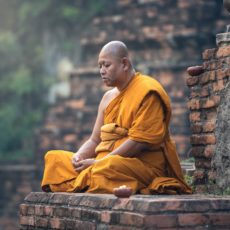As an Amazon Associate I earn from qualifying purchases.
There is hardly a better-known piece of yoga equipment than the yoga mat. Everybody who’s ever used a mat during practice has noted the variety of the materials, shapes and even sizes available. In this article, we are taking a dive into the use, make, and history of the yoga mat. Of course, we’ll provide you with some tips on how to select the best mat for your own practice. Let’s start!
Why a Mat?
Yoga Mats are created to support the practitioners during postures (asanas), softening the contact with the floor or the ground. They also help you avoid slipping on the floor. Moreover, some companies produce “Alignment” mats which include images and / or markings to guide for proper alignment.
How Did The Mats Come About?
Since ancient times in India, yoga practitioners and scholars have used various forms of insulation during practice. The Hindu scripture Bhagavad Gita recommends kusha grass and antelope skin as part of the ideal seat for meditation. Some early practitioners performed asanas on the ground without a cover, some even used tiger skin rugs.
With the emerging popularity of yoga in the West during the second half of the 20th century, many practitioners used towels, blankets, or cotton rugs. Rubber mats were introduced as an intermediate material to prevent cotton mats from slipping on wooden floors.
The mat as we know it, however, is quite a modern achievement. British yoga Teacher Angela Farmer has been credited with the invention of the yoga mat we know and love today. In 1982, while teaching yoga in Germany, Angela Farmer used a carpet underlay cut the size of a towel while doing yoga. Upon her return to London, Angela’s father contacted a German padding manufacturer and became the first retailer of “sticky mats”. The rest is history.
Basic Tips When Selecting a Mat
Your mat should help, protect, and support you in your practice. It should not distract you, annoy you, or contribute to injury in any way. So here are some tips to help you select a suitable yoga Mat. Look for a mat that is soft and provides insulation. The mat should be thick enough so that you could plant your knees, elbows, and ankles on it during the asana practice.
Generally, beginners may feel more comfortable with a thicker mat. If you are an advanced practitioner and are looking for a mat you can bring along when you travel, special thin travel mats are available to help you pack light. Beware that exercise mats are sometimes too thick and give in under your weight, thus that they make it hard for you to keep your balance.
The mat should not “ride” the floor like a regular house carpet. You should be confident your mat will not move around when you practice. This is the only way you would feel confident with more advanced yoga moves.
You should be able to hold a good grip on the mat, without your hands or feet sliding. If you have the opportunity to actually try out a mat before making a decision, the Downward-Facing Dog (Adho mukha svanasana) is a great posture to test for sliding.
Cheap or expensive, thick or thin, pick up a mat that you love. If you don’t love it, you will not use it. Just go with your heart, like with all great romances 😉
Mat Maintenance
Yes, you need to clean your mat. How often you clean it depends on how often you use it, where you use it, even the type of practice you do (considering blood, sweat, tears, and all…). Here is the tricky part: what you clean your mat with would depend on the material of it is made out of.
The first commercially produced yoga mats were made from synthetic materials (PVC, polyurethane, etc.). More recently, mats are also produced from natural jute, organic rubber, and even cork. The chemicals used in some soaps, however, can destroy natural rubber. Most mats would include general care instructions and tips on how to wash them, so make sure to read those or search online according to the specific type of mat you need to clean.
Moreover, excess heat and sunlight can cause loss of color and degradation of the material of the mat. If you are absolutely addicted to outdoor practices you can splurge for a special towel to put over the mat. These towels have also proven useful against slipping in practices that entail profuse sweating.
Lastly, make sure to keep your mat in a space where it will not be under direct sunlight and where you can keep it rolled up without distorting its shape.
Final Words
Very often, in yoga studios and during practice, the mats are referred to as a symbol of the individual desire for transcendence or personal health, as opposed to social activity. However, the mat is not only a private island of serenity but also an opportunity to align you with other like-minded individuals in your path forward. It is a symbol of global practice and a universal ideal for self-improvement.
In practical terms, the yoga mat is an investment that you make in yourself, your health, and your peace of mind. It is the first step on a journey that can help you develop new knowledge, rediscover what you have lost or forgotten, open yourself up to others and to the world. Your choice of the mat can depend on your overall fitness, the type of practice you prefer, or can simply be an aesthetical decision. In any case, you should strive to use the mat wisely and mindfully, keep it safe, and enjoy it immensely.
Amazon and the Amazon logo are trademarks of Amazon.com, Inc, or its affiliates.



